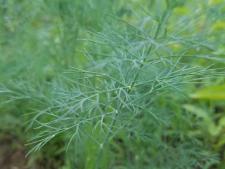Dill is an aromatic herb from the celery family that can elevate the flavor and visual appearance of a variety of dishes. The green fronds are delicate and feathery with a soft, sweet taste with notes of licorice. Besides being widely used as a garnish, dill adds a wonderful flavor to dressings, dips, sauces, slaws, pickles, ferments, potatoes, soups and salads. It is especially popular in Scandinavian, European and Russian cuisine.
VOLUME
Quiet
PH EFFECT
Highly alkaline.
HOW TO USE
Dill fronds are very delicate and can easily wilt and slump. The herb will loose flavor, nutrition and life force if cooked, so it´s recommended to use raw or add after cooking.
Chopped fresh dill is a wonderful ingredient in vegan yogurt dips such as raita, tzatziki or ranch. It is also great to add to a vegan egg salad or tofu scramble. Another great combination is papaya salmon with fresh dill.
The dill flower is edible too, the flavor is even stronger than the dill fronds, although the texture can be a bit tough. Since the flower is not as delicate as the fresh dill fronds, it is a great addition to the a vegetable broth or a pot of simmering potatoes. Adding dill flower to a jar of pickles or marinated coconut feta is another great way to get both a wonderful flavor and visual effect.
FLAVOR PAIRINGS
Artichokes, asparagus, beets, bell peppers, black pepper, cabbage, capers, carrots, cauliflower, celery, chives, cilantro, corn, cucumber, eggplant, fennel, garlic, ginger, grains, green pepper, honey, horseradish, kale, kohlrabi, lemon, lime, millet, miso, mushrooms, nut cheeze, olive oil, onions, paprika, parsley, peas,pickles, poppy seeds, potatoes, pumpkin, rice, sauerkraut, spinach, tahini, tofu, vegan cream cheeze, vegan feta, vegan egg dishes, vegan mayonnaise, fvegan salmon, vegan sourcream, vegan yogurt, veggie noodles, vinegar, zucchini.
SELECTING
The leaves of fresh dill should look feathery and green in color.
STORING
Avoid chopping or washing dill until ready to use. Store wrapped in a paper towel and in a sealed plastic bag or container in the refrigerator. Keep in mind that fresh dill has a short shelf life of just a few days. To extend shelf life, store upright in a glass with stems fresh cut and submerged in a few centimeter of water, then covered with a plastic bag and place in the refrigerator.
You can dehydrate dill, and store it in a sealed container in a dark, dry and cool place for up to 6 months. However, dried dill looses some of its original fragrance and flavor. Another long term storage of dill that preserves more of the flavor is freezing. Place the dry whole or chopped sprigs in a sealed zip-lock bag or container in the freezer. Avoid washing prior to freezing if possible. If your dill needs washing, spin or pat thoroughly until dry before freezing.
SUBSTITUTIONS
Use chervil, tarragon or fresh fennel fronds to replace fresh dill as a garnish or to add a fresh and colorful pop to your food. In some recipes dill seeds can be used in place of fresh dill, although the seeds are a very different ingredient, more similar to fennel or anise seeds, and should be added early in the cooking process and in significantly smaller amounts.
HEALTH BENEFITS
Full of minerals such as calcium, phosphorous, magnesium, manganese and iron, dill is a highly alkalizing herb that is great for bone density and protect against rheumatoid arthritis and osteoporosis.
Dill is soothing for digestion, bloating, flatulence, acid reflux and upset stomach. It is even said to help protect the gut against parasites. In fact, the name dill comes from the ancient Norwegian word dilla, meaning soothe.
Just like cloves, cinnamon and nutmeg, dill contains an essential oil called Eugenol, a healing compound with anaesthetic, anticeptic, antiviral and anti-inflammatory properties. This essential oil has bacteria regulating effects, and can be applied topically to wounds, scrapes and cuts as a natural disinfectant to prevent bacterial overgrowth.
Medicinal flavonoids and monoterpenes in dill have a unique ability help with respiratory disorders and neutralize smoke from cigarettes, burning trash, and other harmful carcinogens in the body. These anti-inflammatory properties have also proven to protect against viral, yeast and fungal infections as well as relieving headaches and protect organs.
HISTORY
Dill has been used for its culinary and medicinal properties for millennia. It was mentioned both in the Bible and in ancient Egyptian scriptures. It was also popular in ancient Greek and Roman cultures, where it was considered a sign of wealth, revered for its many healing properties.
REFERENCES
- Mateljan, George. The World´s Healthiest Foods. Nov 2020 http://www.whfoods.com/index.php
- Ensminger AH, Esminger M. K. J. e. al. Food for Health: A Nutrition Encyclopedia. Clovis, California: Pegus Press; 1986. 1986. PMID:15210.
- Fortin, Francois, Editorial Director. The Visual Foods Encyclopedia. Macmillan, New York. 1996.
- Grieve M. A Modern Herbal. Dover Publications, New York. 1971.
- Singh G, Kapoor IP, Pandey SK et al. Studies on essential oils: part 10; antibacterial activity of volatile oils of some spices. Phytother Res 2002 Nov;16(7):680-2. 2002.
- Wood, Rebecca. The Whole Foods Encyclopedia. New York, NY: Prentice-Hall Press; 1988. 1988. PMID:15220.
- Zheng GQ, Kenney PM, Lam LK. Anethofuran, carvone, and limonene: potential cancer chemopreventive agents from dill weed oil and caraway oil. Planta Med 1992 Aug;58(4):338-41. 1992. PMID:12200.
